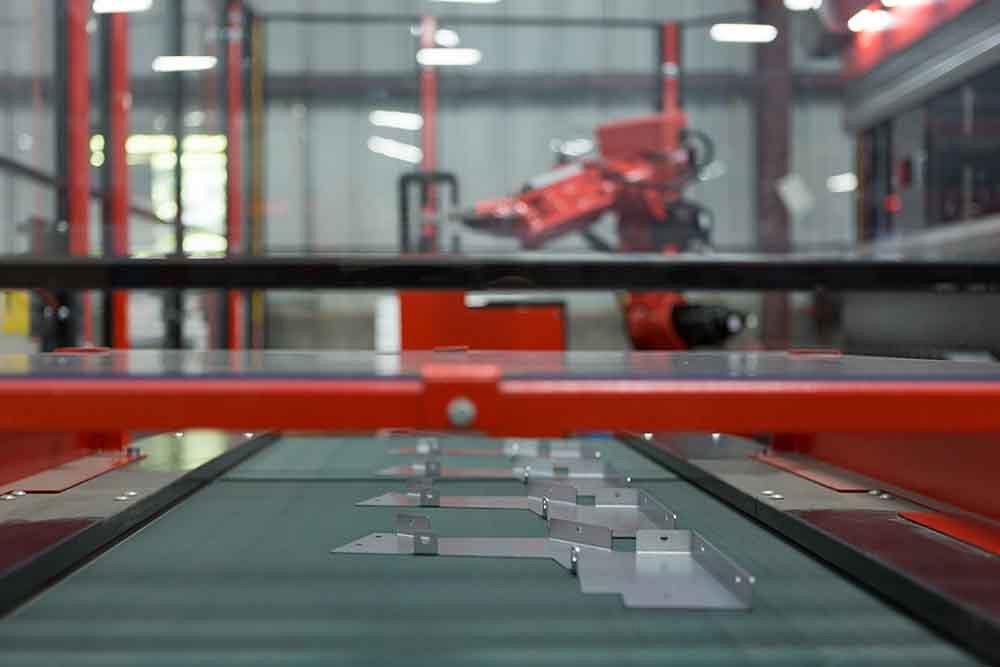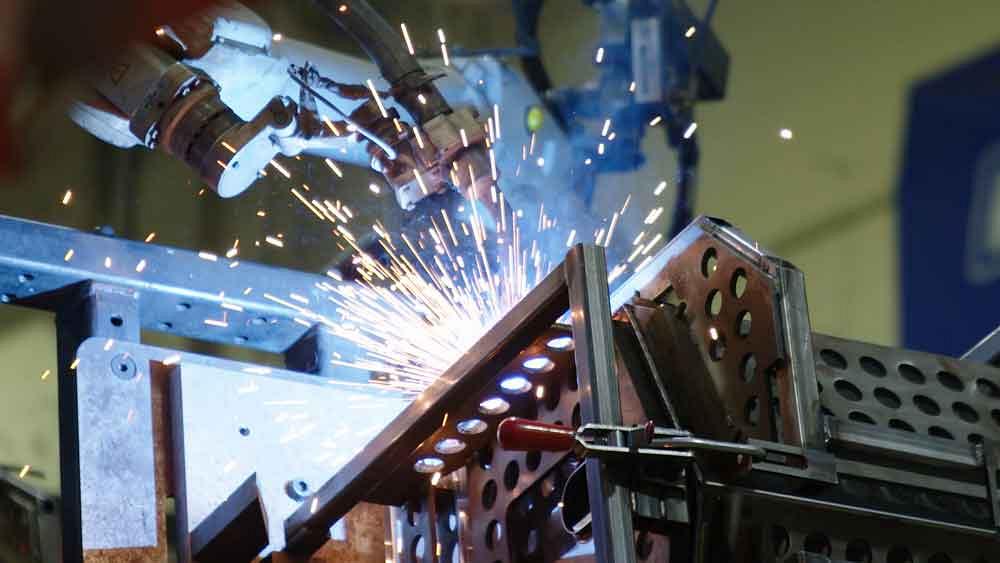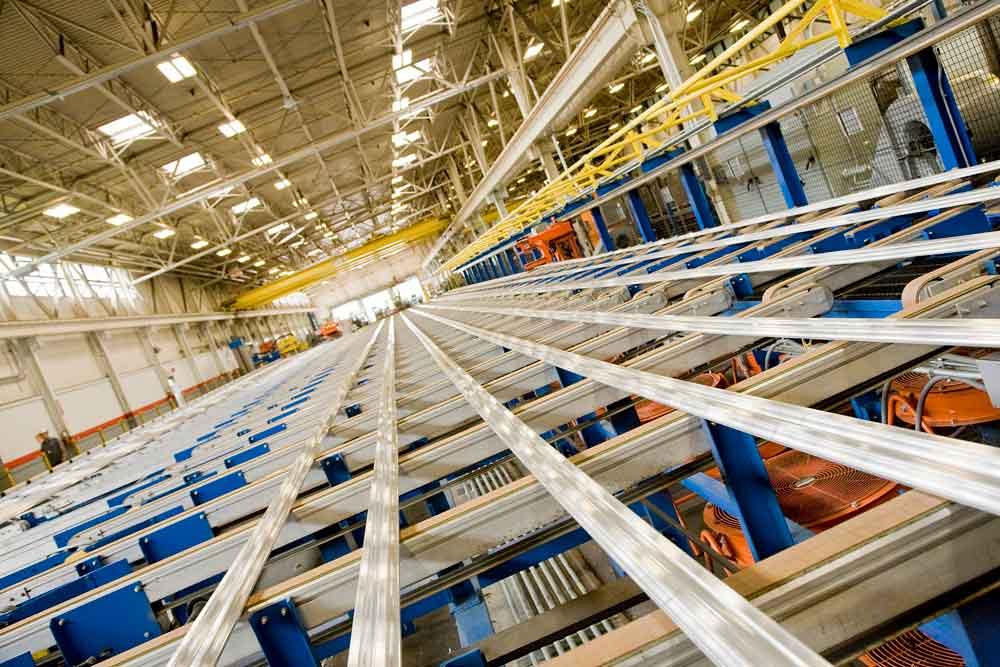Senior Editor
- FMA
- The Fabricator
- FABTECH
- Canadian Metalworking
Categories
- Additive Manufacturing
- Aluminum Welding
- Arc Welding
- Assembly and Joining
- Automation and Robotics
- Bending and Forming
- Consumables
- Cutting and Weld Prep
- Electric Vehicles
- En Español
- Finishing
- Hydroforming
- Laser Cutting
- Laser Welding
- Machining
- Manufacturing Software
- Materials Handling
- Metals/Materials
- Oxyfuel Cutting
- Plasma Cutting
- Power Tools
- Punching and Other Holemaking
- Roll Forming
- Safety
- Sawing
- Shearing
- Shop Management
- Testing and Measuring
- Tube and Pipe Fabrication
- Tube and Pipe Production
- Waterjet Cutting
Industry Directory
Webcasts
Podcasts
FAB 40
Advertise
Subscribe
Account Login
Search
Metal fabrication, machining, and extrusion: Better together
Momentum Manufacturing Group finds growth in metalworking process diversity
- By Tim Heston
- July 27, 2020
- Article
- Shop Management
Some in metal manufacturing are moving away from the term supplier, mainly because it doesn’t illustrate the full breadth of capabilities behind the relationship of two complementary manufacturing businesses.
Many successful job shops have the financial stability of a well-diversified customer mix that demands a range of services, from the “make this part to print” to working with someone who comes to the shop with an idea and a napkin sketch.
That range of services has different levels of customer “stickiness,” or how easy it is for a customer to break the relationship and move to a competitor. If it’s just about price, customer stickiness is next to none. Add good quality and delivery and the stickiness increases a bit, but not extraordinarily so. After all, every good job shop competes on price, quality, and delivery.
This is where terms like partnership and strategic solutions provider enter the fray. They can sound hackneyed, but not when truth and quality work back them up—which is what successful fabricators do.
OEMs aim to reduce risk by sourcing locally instead of globally. They also want to simplify their supply chains and reduce their vendor count, though not at the expense of excessive risk. But if the supplier (or “solutions provider”) happens to have multiple plants in different locations with redundant capabilities (a benefit in the age of COVID-19), the risk goes down. If those locations have a range of metal manufacturing options, collaboration extends further, potential cost savings rise with reduced handling, and risk continues its descent. That in a nutshell is the idea behind Momentum Manufacturing Group.
Acquisition Trail
“From a strategic standpoint, we want to be more than a fabricator, a machine shop, and an extruder. We can collaborate as a group and provide multiple solutions, whether it’s engineering services, fabrication, machining, extrusion or contract manufacturing, or assembly. It also helps that many buyers are trying to reduce the number of vendors they work with, and that was a big part behind the company’s rebranding.”
So said Steven Gore, Momentum’s senior vice president. Gore joined the company in August 2019, a time of significant change for the organization. It was then known as NSA Industries, with its main plant in St. Johnsbury, Vt. By that point the fabricator had already experienced a spate of growth. In 2014 it bought a nearby machine shop called KC Precision Machining, a move that greatly expanded its machining capability. Then in 2016 it acquired New Hampshire Precision Metal Fabricators in Londonderry and absorbed the operation within its St. Johnsbury plant.
In December 2018 it acquired Metal Tronics, a custom metal fabricator in Georgetown, Mass. Then in January of this year it acquired a Franklin, N.H., aluminum extrusion provider called Vitex Extrusion.
“Vitex had been an NSA customer for more than 25 years,” Gore said. “Because we had such a close relationship for so many years, at some point the conversation [about a potential acquisition] started.” Vitex already had machining and fabrication as value-added services that complemented its main extruding business. It just made sense for them to be part of a larger whole, with much more extensive fabrication, machining, not to mention painting and powder coating.
In February 2020 the “larger whole”—that is, the sum of NSA Industries, Vitex Extrusion, Metal Tronics, and KC Precision Machining—changed its name to Momentum Manufacturing Group.

A conveyor in Momentum’s robotic bending cell transports formed parts to the next manufacturing step.
Strategic Consolidation
Custom and contract metal fabrication remains a fractured industry, with a few large operations—many of which (including Momentum) are in this magazine’s FAB 40 list, published in June and available at thefabricator.com—and a long tail of small shops.
The range of company sizes in this business reflects the industry’s range of customers. Most fabricators grow on the backs of a handful of large customers while having a long tail of smaller accounts. According to a 2019 benchmarking survey from the Fabricators & Manufacturers Association, only about seven large-dollar customers make up more than 50% of the revenue at a typical custom fabricator.
In that same survey, respondents reported that about 6% of revenue came from new customers, most if not all of whom start in that long tail of small-dollar accounts. If a fabricator offers good prices, high quality, and good delivery performance, over time that small customer becomes a larger one—at least that’s the intent. The question is, how does an operation turn more small customers into major ones?
This is where some of the industry’s consolidation strategies, including those employed at Momentum, come into play. Today Momentum has an unusual mix of metal manufacturing technology. The former Metal Tronics facility specializes in lower-volume sheet metal fabrications. It also specializes in the fabrication of lead-based products using tailored methods in punching and assembly that, among other things, prevent workers from being exposed to metal dust.
The former NSA operation focuses on the full range of sheet metal fabrication part volumes, with extensive cutting, forming, and welding automation. For instance, it has several cells that carry a variety of workpieces from laser cutting and robotic bending on to hardware insertion and welding, complete with conveyor-based and other automated part handling techniques. The former KC Precision plant offers high-end machining, and again, Vitex offers extrusions.
All these organizations could have kept doing business under separate brands. But as Gore explained, merging operations under one brand has distinct benefits—and a few just happened to involve a pandemic and ensuing economic turmoil: quick-response and flexible capacity.
The Demand Yo-Yo
In late March and throughout April, senior managers across Momentum held daily Zoom calls. Like most fabricators across the country, Momentum had customers in sectors that the government deemed essential, so the fabricator kept its doors open. Everyone who could work from home did, while those in the shop worked under stringent cleaning and distancing protocols. It closed plants to visitors and set up outside facilities for truck drivers, so they wouldn’t need to enter the building when making deliveries.
Customers called daily to push back orders, then reinstate them, then to push them back again. Uncertainty reigned, especially during the first few weeks of the pandemic. “We were on the phone with our key customers several times a week,” Gore recalled. “The demand was like a yo-yo. We had customers in sectors deemed nonessential that were shut down, while other customers, especially those in the logistics business connected with home deliveries, ramped up and accelerated their orders. So, we identified where we had newly opened capacity and shifted the work load.
“We’re going to get through this,” Gore continued. “It’s a temporary thing, and we see tremendous opportunity. We feel that once we get through the crisis, the growth will return, and we believe we’ll start to see even more reshoring of manufacturing in the U.S. And with the investments we’ve made, we’re well-positioned to scale up quickly.”
The Engineering Council
It’s a simple concept. As part of the engineering council, key sales, engineering, and technical personnel from across the entire Momentum group meet periodically, usually monthly, to coordinate large projects and discuss opportunities involving collaboration and best practices.

Momentum’s robotic bending cell with automatic tool change is tailored for high-product-mix production.
Those best practices can be general, like specific 5S techniques and other lean concepts employed at different plants, but they can also be job-specific. For instance, the team found a recent order that ran in the former Metal Tronics plant could be made much more efficiently with a tube laser, and the former NSA plant has that capability. Meanwhile, NSA’s welding department was nearing capacity, so it sent more welding work to the Metal Tronics plant.
Another recent example involved an area of hot demand: ventilator parts. “As you can imagine, they’re ramping up,” Gore said. “We were buying standard aluminum stock material, but it’s pretty high volume. We had our team at Vitex look at it, and they found they could actually extrude the plates, which saved material costs and helped control the quality, time, and delivery dates, since it’s all coming out of our own factory.
“We’re not a $25 million company anymore,” Gore added. (In 2019 Momentum reported sales of $124 million.) “We now need to think bigger and leverage each other’s resources and capabilities.”
The organization hasn’t merged its quoting teams. Many have longstanding relationships with existing customers, and so far Momentum has found that the intimate knowledge of the local facility’s shop floor helps the quoting process. But the engineering council is always there to assist. And before the pandemic, sales and estimating personnel from across the company visited other Momentum plants to see best practices and learn about specific manufacturing technologies, including their strengths and weaknesses. Gore said such visits will continue once the crisis subsides.
People and Processes
Competitive success hinges on advantages—rooted in talented personnel and advanced manufacturing technologies—that are difficult for others to copy. Talent can be poached, of course, but how a talented person works within a specific company’s culture is impossible to duplicate. Manufacturing technology can be duplicated; after all, most metal fabrication technology is purchased, not proprietary to a single fabricator. But duplicating an entire mix of technologies—extrusion, powder coating, machining, laser cutting, panel bending, robotic press brakes—isn’t so easy.
It boils down to having unique people and processes. Thus far, Momentum’s strategy has involved both.
About the Author

Tim Heston
2135 Point Blvd
Elgin, IL 60123
815-381-1314
Tim Heston, The Fabricator's senior editor, has covered the metal fabrication industry since 1998, starting his career at the American Welding Society's Welding Journal. Since then he has covered the full range of metal fabrication processes, from stamping, bending, and cutting to grinding and polishing. He joined The Fabricator's staff in October 2007.
subscribe now

The Fabricator is North America's leading magazine for the metal forming and fabricating industry. The magazine delivers the news, technical articles, and case histories that enable fabricators to do their jobs more efficiently. The Fabricator has served the industry since 1970.
start your free subscription- Stay connected from anywhere

Easily access valuable industry resources now with full access to the digital edition of The Fabricator.

Easily access valuable industry resources now with full access to the digital edition of The Welder.

Easily access valuable industry resources now with full access to the digital edition of The Tube and Pipe Journal.
- Podcasting
- Podcast:
- The Fabricator Podcast
- Published:
- 04/30/2024
- Running Time:
- 53:00
Seth Feldman of Iowa-based Wertzbaugher Services joins The Fabricator Podcast to offer his take as a Gen Zer...
- Industry Events
Pipe and Tube Conference
- May 21 - 22, 2024
- Omaha, NE
World-Class Roll Forming Workshop
- June 5 - 6, 2024
- Louisville, KY
Advanced Laser Application Workshop
- June 25 - 27, 2024
- Novi, MI
Precision Press Brake Certificate Course
- July 31 - August 1, 2024
- Elgin,

































